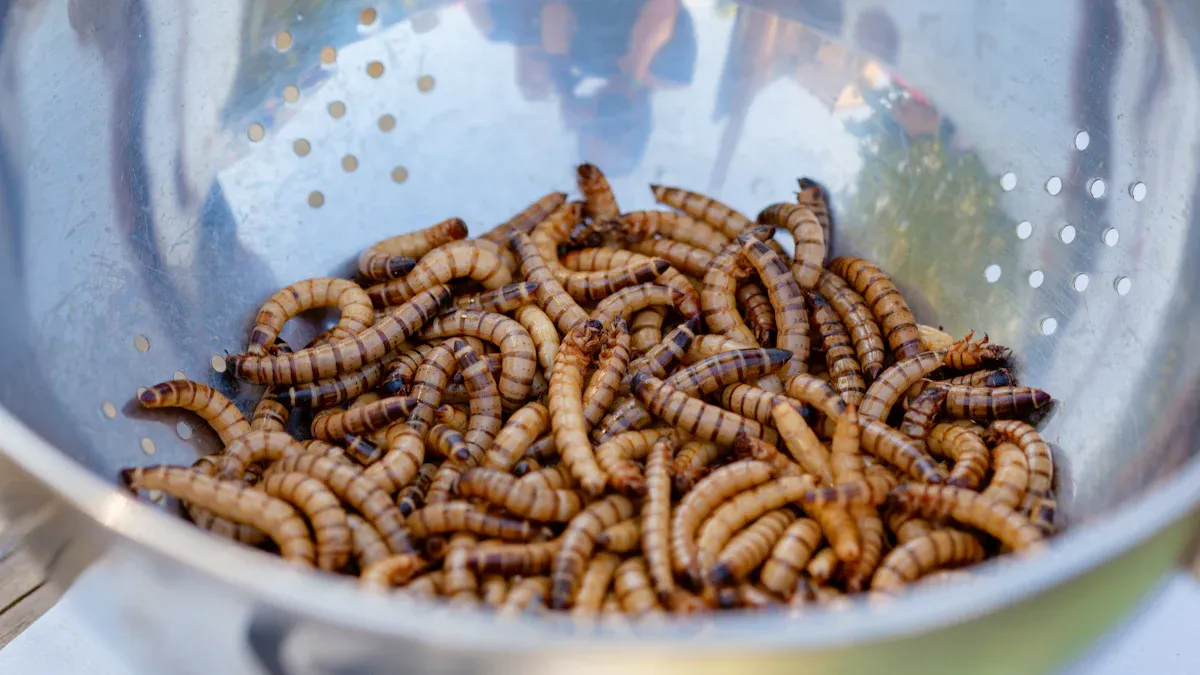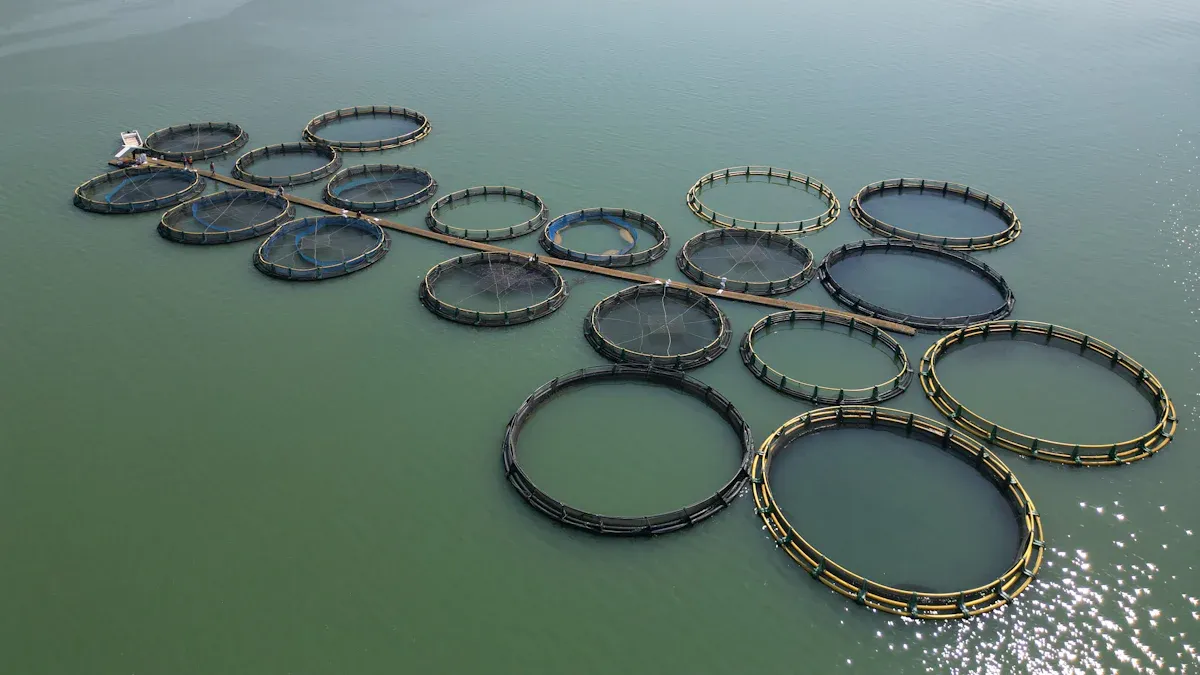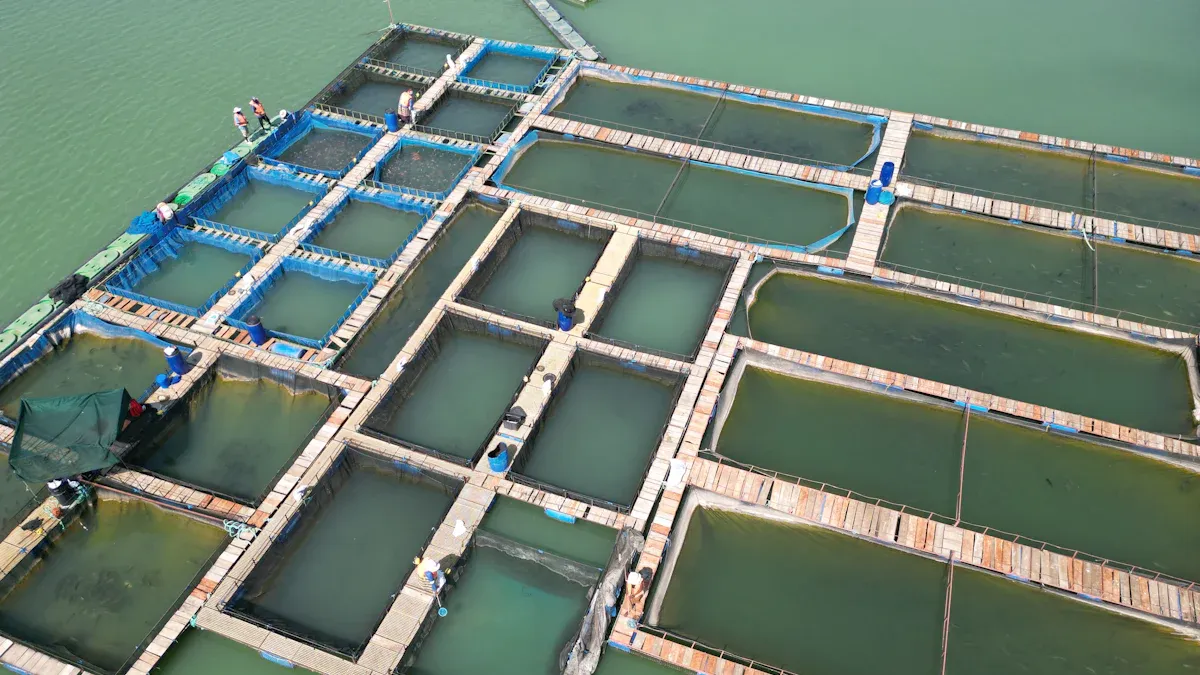
Have you ever wondered how to make aquaculture more sustainable? Dried mealworms might be the answer you’re looking for. These tiny insects pack a punch when it comes to nutrition. They’re loaded with protein and essential nutrients, making them a fantastic alternative to traditional fish feed. Plus, they’re eco-friendly. Producing one ton of mealworms uses only 4341 m³ of water, far less than beef. With their cost-effectiveness and ability to improve feed efficiency, dried mealworms for aquaculture could revolutionize fish farming in Africa.
Key Takeaways
- Dried mealworms are a healthy and eco-friendly option for fish feed. They have up to 79% protein, which helps fish grow well.
- Adding dried mealworms to fish food can make fish grow faster. It also lowers feeding costs, helping farmers earn more money.
- Using mealworms instead of fish meal protects the ocean. It reduces the need for overfished resources like fish meal and fish oil.
Challenges in Aquaculture Nutrition
Aquaculture in Africa faces several hurdles when it comes to fish feed. These challenges impact fish growth, farm productivity, and the overall sustainability of the industry. Let’s dive into the key issues.
Limited access to high-quality feed
Accessing high-quality fish feed remains a significant challenge. Many farmers struggle to find affordable and effective options. While progress has been made by replacing fish meal with alternative protein sources, there are still gaps. Carnivorous fish species, for example, often require specialized diets that are hard to replicate with local ingredients.
Commercial mealworms, though promising, have their limitations. They contain about 30% fat but lack omega-3 fatty acids, which are essential for fish health. This nutritional gap can reduce their effectiveness as a complete feed alternative.
Here’s a quick look at some challenges related to feed quality:
| Challenge | Description |
|---|---|
| Protein Quality | Low methionine levels and absence of n-3 HUFAs limit their use as protein. |
| Antinutritional Factors | Chitin affects digestibility and mineral absorption. |
Overdependence on unsustainable feed sources
Many aquaculture farms rely heavily on fish meal and fish oil, which are not sustainable. Overfishing to produce these ingredients harms marine ecosystems. Mealworm farming could be a solution, but it also faces sustainability issues. Farmers often depend on food-grade or imported substrates to grow mealworms, which increases costs and environmental impact.
Rising costs of traditional feed ingredients
The cost of traditional feed ingredients continues to rise, making it harder for farmers to stay profitable. Prices vary globally, but they remain high across the board:
| Region | Price (USD/kg) |
|---|---|
| South Korea | 65–70 |
| Europe | 12.9–20 |
| United States | 10.8–14 |
| China | 8.4–9.4 |
These rising costs push farmers to explore alternatives like dried mealworms. However, affordability remains a concern, especially for small-scale farms.
By addressing these challenges, African aquaculture can unlock its potential and move toward a more sustainable future.
Dried Mealworms for Aquaculture: Nutritional and Economic Benefits

High protein content for fish growth
Did you know that dried mealworms are packed with protein? They contain up to 79% protein, making them a powerhouse for fish growth. This high protein content supports muscle development and overall health in fish. However, there’s a catch. Mealworms also contain chitin, a component that can reduce protein digestibility. To get the best results, you’ll need to balance their inclusion in fish diets carefully. Despite this, studies show that substituting traditional fish meal with mealworms can lead to comparable or even improved growth rates in aquaculture. It’s a win-win for your fish and your farm.
Rich in essential amino acids and healthy fats
Dried mealworms for aquaculture aren’t just about protein. They’re also rich in essential amino acids like valine, histidine, and glycine, which are crucial for fish health. These amino acids help with tissue repair and immune function. On top of that, mealworms are a great source of healthy fats, including oleic and linoleic acids. These fats provide energy and improve the quality of fish meat. While they lack omega-3 fatty acids, you can easily supplement this with other feed ingredients. By incorporating mealworms, you’re giving your fish a balanced and nutritious diet.
Cost-effective and sustainable alternative to fish meal
Let’s talk about costs. Traditional fish meal prices are skyrocketing, but mealworms offer a more affordable option. Yellow mealworms, in particular, are recognized as a low-cost protein source. They have a nutritional profile similar to fish and soybean meal, making them a viable alternative. Plus, they’re sustainable. Mealworm farming requires fewer resources, reducing the environmental impact of aquaculture. By switching to dried mealworms for aquaculture, you’re not just saving money—you’re also contributing to a greener planet.
Practical Applications and Success Stories

Incorporating dried mealworms into feed formulations
You might wonder how to include dried mealworms for aquaculture in fish feed. Research shows that mealworms can replace up to 25% of traditional fishmeal in diets for various species. This inclusion rate delivers positive growth results without compromising fish health.
Here’s a quick look at how different species respond to mealworm-based diets:
| Fish Species | Inclusion Rate | Growth Performance Assessment |
|---|---|---|
| Rainbow trout (Oncorhynchus mykiss) | Up to 25% | Positive |
| Gilthead sea bream (Sparus aurata) | Up to 25% | Positive |
| Tilapia (Oreochromis niloticus) | Up to 25% | Positive |
Mealworms are also sustainable. The EU has approved their use in aquaculture, recognizing their high protein and energy content. This makes them a practical choice for eco-friendly fish farming.
Positive outcomes in fish health and growth
Switching to mealworm-based feed doesn’t just help the environment—it benefits your fish too. Studies reveal that fish fed with up to 25% mealworm meal show comparable growth to those on traditional diets. For example, red hybrid tilapia thrive with this inclusion rate.
Mealworms also improve protein efficiency ratios, ensuring your fish get the nutrients they need. However, higher inclusion rates may reduce diet acceptability, so balance is key.
Examples of successful African aquaculture farms
Across Africa, farms are already reaping the benefits of mealworm-based feeds. In Kenya, tilapia farmers report better growth rates and reduced feed costs. In Nigeria, mealworm farming initiatives are helping small-scale farmers produce sustainable fish feed locally. These success stories highlight the transformative potential of dried mealworms for aquaculture.

Dried mealworms are revolutionizing aquaculture in Africa. They’re packed with protein, essential amino acids, and healthy fats, making them a powerful alternative to traditional fishmeal.
- Benefits include:
- Increased shrimp body weight and lipid content.
- Reduced reliance on imported feed.
- High protein content (20–76%) based on diet.
| Metric | Mealworms (per 100g) | Soy (per 100g) |
|---|---|---|
| Total Essential Amino Acids | 31.49 g | 26.02 g |
| Protein Content | 51.93 g | 44.51 g |
| CO2 Equivalent (per kg) | 3.8 kg | N/A |
By embracing mealworms, you’re not just feeding fish—you’re feeding the future. 🌍
FAQ
What makes dried mealworms for aquaculture a sustainable choice?
Mealworms require fewer resources like water and land compared to traditional feed sources. Their farming also produces less waste, making them an eco-friendly option for aquaculture.
Can dried mealworms completely replace fishmeal in aquaculture diets?
Not entirely. Mealworms can replace up to 25% of fishmeal in most diets. Balancing their inclusion ensures optimal fish growth and health.
Are dried mealworms for aquaculture safe for all fish species?
Yes, they’re safe for most species. However, you should consult feed formulation guidelines to ensure proper nutrition for your specific fish type.


